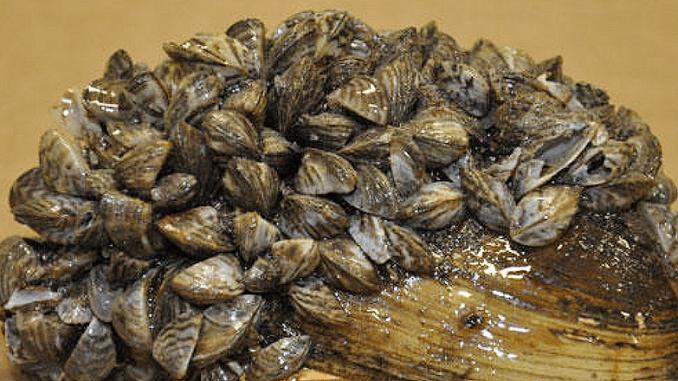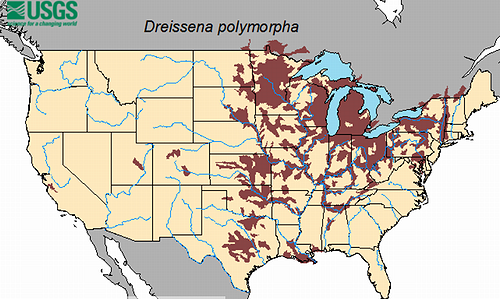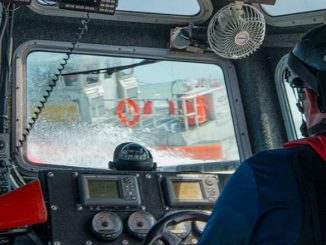
LONGVILLE, Minnesota, October 9, 2021 (ENS) – For the first time, the Minnesota Department of Natural Resources has sounded the alarm to notify the public the agency is fighting invasive zebra mussels in Woman Lake, near Longville. The Woman Lake Chain, a popular chain of four Minnesota lakes renowned for their abundant fish, begins on the Longville shore and includes Child Lake, Girl Lake and Little Woman Lake.
Girl Lake, connected to Woman Lake, will also be added to the infested waters list, the DNR said.
The invasion started last year, when a lake property owner reported a single, small zebra mussel attached to a dislodged portion of his dock. No zebra mussels were found during a DNR snorkel search nor during a dive by the Cass County search and rescue team.
But this summer, two more lake property owners reported finding individual adult zebra mussels. Again, no zebra mussels were found during follow-up searches.
In late September, a county aquatic invasive species inspector found a juvenile zebra mussel on a pontoon boat being removed from Woman Lake for the season.
The Cass County aquatic invasive species specialist examined the pontoon boat and found one more juvenile mussel attached. As this boat is only used on Woman Lake, the DNR has now confirmed the presence of zebra mussels in the lake.
Heidi Wolf, DNR invasive species unit supervisor, said, “Lake property owners and county staff play an important role in detecting invasive species, by carefully examining boats, docks and lifts when they are being removed from the water at the end of the season.”
There are 43 Minnesota lakes that already have been invaded by the tiny mussels, according to the U.S. Geological Survey’s Nonindigenous Invasive Species Chart, but this is the first time they have been found in the Woman Lake Chain.
Rapid Invasion of the Great Lakes
Zebra mussels, Dreissena polymorpha, are a fingernail-sized mollusk native to the Black, Caspian, and Azov Seas of Eastern Europe. Their name comes from the dark, zigzag stripes on each shell. By the late 18th century, zebra mussels had spread through newly constructed canals from those seas to the major drainages of Europe.
The first report of zebra mussels in the United States was in 1988 when mussels were found in Lake St. Clair, a freshwater lake spanning the Canadian province of Ontario and the U.S. state of Michigan.

The U.S. Fish & Wildlife Service says these mussels were transported from Europe in the ballast tanks of large shipping vessels. By 1990, zebra mussels had spread into all five Great Lakes. Over the next two years, they spread to the Illinois, Hudson, Arkansas, Cumberland, Hudson, Mississippi, Ohio, and Tennessee rivers.
Zebra mussels have continued to spread rapidly throughout the Great Lakes region and into the large rivers of the eastern Mississippi drainage. They have been found in Texas, Colorado, Utah, Nevada, and California.
These tiny invaders adversely affect aquatic microorganisms, kill native mussels, ruin fish spawning areas, damage structures and clog water supply pipes and other infrastructure.
Boat owners can do a great deal to slow the spread of these mussels. Boats and equipment may be pressure washed to remove veligers and juvenile zebra mussels. Biologists who have studied zebra mussels recommend using high-pressure hot water to remove and kill zebra mussels that are attached to a boat hull or other equipment.
Minnesota law requires that docks and lifts remain out of the water for at least 21 days after removal from a waterbody before they can be placed into another body of water.
In addition, anyone who transports a dock or lift from a shoreline property to another location for storage or repair may need a permit (link is external) to help prevent the spread of aquatic invasive species.
Lake property owners are asked to look on the posts, wheels and underwater support bars of docks and lifts, as well as any parts of boats, pontoons and rafts that may have been submerged in water for an extended time.
Anyone paid to remove boats, docks, lifts and other water-related equipment must be DNR trained and permitted. Click here for a list of DNR-permitted lake service provider businesses. More information is available here.
Featured image: Zebra mussels, each the size of a small fingernail, have attached themselves to a native mussel in Minnesota. 2016 (Photo courtesy Minnesota Aquatic Invasive Species Research Center, University of Minnesota)



